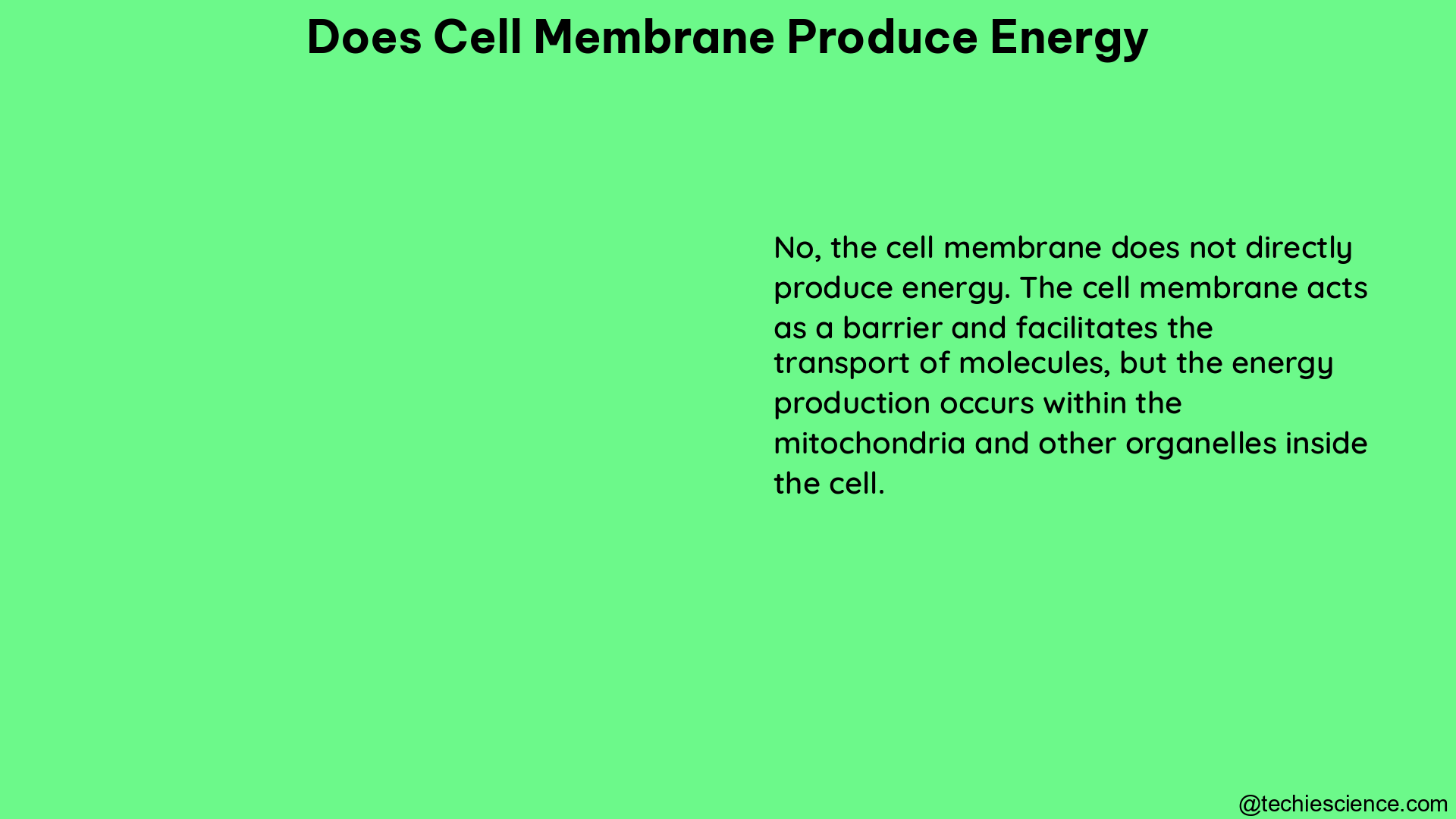The cell membrane, also known as the plasma membrane, is a crucial component of all living cells, playing a vital role in regulating the movement of molecules and ions in and out of the cell. Contrary to popular belief, the cell membrane does not directly produce energy. Instead, it facilitates the processes necessary for energy production within the cell.
The Structure and Function of the Cell Membrane
The cell membrane is composed of a phospholipid bilayer, with hydrophilic (water-loving) heads facing outwards and hydrophobic (water-fearing) tails facing inwards. This unique structure allows the membrane to be selectively permeable, meaning it can control the movement of specific molecules and ions in and out of the cell.
The cell membrane is not just a passive barrier; it contains a variety of specialized proteins that perform various functions, such as:
- Transport Proteins: These proteins facilitate the movement of molecules and ions across the membrane, either through passive transport (down the concentration gradient) or active transport (against the concentration gradient, using energy).
- Receptor Proteins: These proteins bind to specific molecules, triggering a response within the cell, such as signaling pathways or changes in gene expression.
- Enzymatic Proteins: These proteins catalyze chemical reactions on the cell’s surface, often as part of signaling cascades or metabolic processes.
- Adhesion Proteins: These proteins help the cell attach to the extracellular matrix or other cells, facilitating cell-cell communication and tissue formation.
Passive Transport Mechanisms

The cell membrane allows certain molecules and ions to pass through it without the expenditure of energy. This process is known as passive transport and includes:
- Diffusion: The movement of molecules from an area of high concentration to an area of low concentration, driven by the concentration gradient.
- Osmosis: The movement of water molecules across the membrane, from an area of low solute concentration to an area of high solute concentration, driven by the water potential gradient.
- Facilitated Diffusion: The movement of molecules or ions across the membrane, assisted by specialized transport proteins that act as “channels” or “carriers.”
Passive transport mechanisms are essential for maintaining the cell’s internal environment, as they allow the cell to regulate the concentration of various molecules and ions, such as oxygen, carbon dioxide, and nutrients.
Active Transport Mechanisms
In contrast to passive transport, active transport mechanisms require the expenditure of energy, typically in the form of ATP (adenosine triphosphate). These mechanisms involve specialized transport proteins that use the energy from ATP hydrolysis to move molecules and ions against their concentration gradient. Examples of active transport mechanisms include:
- Sodium-Potassium Pump: This pump uses ATP to actively transport sodium ions (Na+) out of the cell and potassium ions (K+) into the cell, maintaining the cell’s resting potential, which is essential for nerve impulse transmission and muscle contraction.
- Calcium Pump: This pump uses ATP to actively transport calcium ions (Ca2+) out of the cell, helping to regulate the concentration of calcium within the cell, which is crucial for signaling pathways and muscle contraction.
- Proton Pump: This pump uses ATP to actively transport protons (H+) out of the cell, creating a proton gradient that can be used to drive the synthesis of ATP through the process of oxidative phosphorylation.
Active transport mechanisms are essential for maintaining the cell’s internal environment, as they allow the cell to regulate the concentration of various molecules and ions, which is necessary for a wide range of cellular processes, including energy production, signaling, and homeostasis.
The Role of the Cell Membrane in Energy Production
While the cell membrane does not directly produce energy, it plays a crucial role in the processes that generate energy within the cell. The cell membrane is involved in several key energy-producing pathways, including:
- Oxidative Phosphorylation: The cell membrane, specifically the inner membrane of the mitochondria, is the site of the electron transport chain, which uses the proton gradient created by the proton pump to drive the synthesis of ATP.
- Photosynthesis: In plant cells, the cell membrane of the chloroplast contains the photosynthetic machinery, which uses the energy from sunlight to produce ATP and other energy-rich molecules.
- Glycolysis: The cell membrane can regulate the transport of glucose and other nutrients into the cell, which are then used as substrates for the glycolytic pathway, a key step in energy production.
By controlling the movement of molecules and ions across the cell membrane, the membrane ensures that the cell has the necessary resources and conditions for efficient energy production, which is essential for the cell’s survival and function.
Conclusion
In summary, while the cell membrane does not directly produce energy, it plays a vital role in regulating the movement of molecules and ions necessary for energy production and maintaining the cell’s internal environment. The cell membrane’s selective permeability, transport proteins, and involvement in key energy-producing pathways make it a crucial component of the cell’s overall energy metabolism and homeostasis.
References:
– Alberts, B., Johnson, A., Lewis, J., Raff, M., Roberts, K., & Walter, P. (2002). Molecular Biology of the Cell. Garland Science.
– Lodish, H., Berk, A., Zipursky, S. L., Matsudaira, P., Baltimore, D., & Darnell, J. (2000). Molecular Cell Biology. W. H. Freeman.
– Stryer, L., Berg, J. M., & Tymoczko, J. L. (2002). Biochemistry. W.H. Freeman.
– Voet, D., Voet, J. G., & Pratt, C. W. (2016). Fundamentals of Biochemistry: Life at the Molecular Level. Wiley.
Hey! I am Sneha Sah, I have completed post graduation in Biotechnology. Science has always been fascinating to me and writing is my passion. As an academic writer my aim is to make Science easy and simple to learn and read.